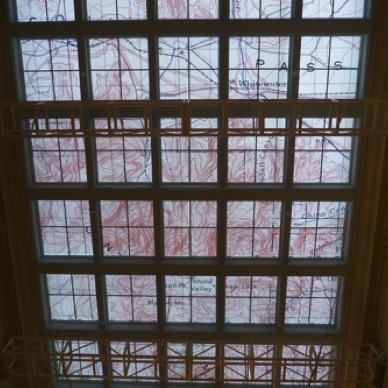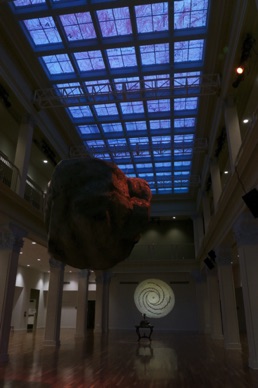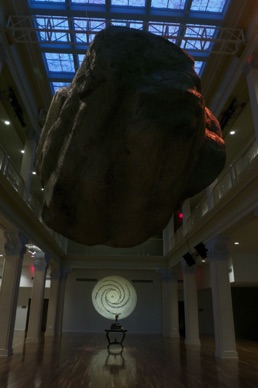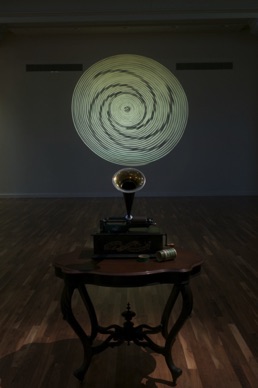Installation work with Erin Neff at the Culver Center for the Arts, UC Riverside
January-March 2012
Tahquitz is a site-specific installation using sound and light technology that animates the majestic forty-foot atrium of UCR’s Culver Center of the Arts. “Tahquitz” (pronounced tah-kwish) is the name of a primordial creature, a nukatem, part of the creation story of the Cahuilla people who live in the Southern California areas of Palm Springs, San Gorgonio Pass, Hemet and Anza Borrego. This primordial being, according to the Cahuilla, wanders in the San Jacinto mountain range where a peak is named for him.

The peak that is named after Tahquitz, which is to the Cahuilla a sacred place, is represented by a large, eight-foot diameter, roughly shaped boulder that hangs just above a viewer’s head in the atrium. Although it is one constructed by a theatrical prop house, there is a sense of gravity and weight that evokes the presence of Tahquitz’s dwelling place. Additionally, it is a reminder of the dry desert location where Tahquitz exists and the reality of living in such a harsh environment, as well as an embodiment of endless hunger and desire, whether by the primordial being, craving for other life energies, or as commentary on today’s society.
deSoto has installed an enormous translucent map of Tahquitz’s location, the San Jacinto Mountain range, across the glass grid of the magnificent glass skylight that lights the Culver Atrium. This map, derived from a USGS map printed in the early 1900s, reverses gravity: one is at once below the map and floating above the land. It suggests that the world has been turned topsy-turvy literally as you enter into the timeless space of Tahquitz. As if told by a Cahuilla, you may become so disoriented as to be unable to leave and return to your family and friends.
On the backside of the atrium’s open space there is a large light projection of a Cahuilla basket pattern that is slowly rotating. Made graphic and enlarged, the spinning design suggests that of a spiral galaxy too, as if to remind the viewer of the cosmic order of things referenced in everyday details of utilitarian objects, such as baskets.
On an antique table, opposite the boulder, there is an Edison cylinder phonograph from the early 1900s. It is a similar to the kind used for recording Cahuilla Bird Singers in 1918 by anthropologist Lucille Hooper. These recordings reside at UC Berkeley’s Phoebe A. Hearst Museum of Anthropology and in the Smithsonian’s collections. The inclusion of both the phonograph and the USGS map from the early 1900s is also fitting as they connect with the installation’s site at Culver Center, a building built originally in 1895 as a department store. The phonograph recording represents also the first time that the sound of another culture could be captured. It also points to how the technology used to record a culture can shape our views, whether that be framed by the two-minute limit of the wax cylinder, the scratchiness of its recording, or which native cultures and songs were selected for dissemination and thus given more importance over others.
There are four zones of sound in the installation. They are created with “audio spotlight” technology that allow for laser-like, precise aiming of sound. As one enters the space, in alignment with the boulder and the recorder down the center of the atrium, the sound of Cahuilla Elder Alvino Siva telling the story of Tahquitz in English and Cahuilla is heard. Standing under the boulder, one hears the sound of Erin Neff, singing a rendition of Siva’s stories. If one passes into the zone of the Edison phonograph, one hears the sounds of "Tahquitz" vocalized by Lewis deSoto and Erin Neff, and then the 1918 Hooper recordings of the Bird Singers is heard. Otherwise, the room feels quiet for anyone not in these specific zones. The effect is not unlike hearing something “inside one’s head” and is an uncanny, unexpected experience. In effect, it is as though the primordial being, Tahquitz, is talking to you, and perhaps ensnaring you, beginning the process of absorbing your life energy.
The stories that Neff sings are about a hunter who has his spirit stolen and consumed by Tahquitz’s deep appetite for the life energies of other living beings. She also sings the complex story of a maiden who is kidnapped and held within his lair: a home inside a seemingly solid boulder on the mountain. She is made to live as he does: consuming the spirits of others. Finally, after much pleading, she is released back into the world and back to her village. After much cajoling she tells the story after having her neighbors build her a house. She perishes after the telling of the forbidden story.




